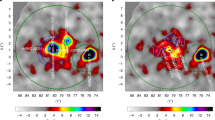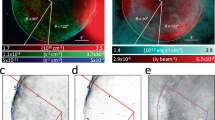Abstract
It is thought that Galactic cosmic-ray nuclei are gradually accelerated to high energies (up to about 300 TeV per nucleon, where 1 TeV is 1012 eV) in the expanding shock waves connected with the remnants of powerful supernova explosions. However, this conjecture has eluded direct observational confirmation1,2 since it was first proposed in 1953 (ref. 3). Enomoto et al.4 claim to have finally found definitive evidence that corroborates this model, proposing that very-high-energy, TeV-range, γ-rays from the supernova remnant (SNR) RX J1713.7 – 3946 are due to the interactions of energetic nuclei in this region. Here we argue that their claim is not supported by the existing multiwavelength spectrum of this source. The search for the origin(s) of Galactic cosmic-ray nuclei may be closing in on the long-suspected supernova-remnant sources, but it is not yet over.
Similar content being viewed by others
Main
We have previously suggested5 that the SNR RX J1713.7 – 3946 (dark X-ray contours in Fig. 1) might be an accelerator of cosmic-ray nuclei on the basis of GeV (109 eV) γ-ray emission6 (Fig. 1, white contours) seen towards adjacent massive and dense molecular clouds (Fig. 1, false colour), with which it seems to be interacting7; the γ-ray signature of nucleonic interactions is known to be greatly amplified in such dense media. Enomoto et al. have since claimed4 that the γ-rays of even higher energy (TeV range) that they detected directly towards the more rarefied remnant (red contours in Fig. 1) are an unambiguous signature of nucleonic interactions in this region, thus finally proving the long-held conjecture.
Red, TeV significance contours4; white, location-probability contours of the GeV (109 eV) EGRET source 3EG J1714 – 3857 (ref. 6); colour scale indicates the intensity of CO (J=1→0) emission, and consequently the column density of the ambient molecular clouds, in the velocity interval v −105 to −80 km s−1 associated with the SNR, corresponding to a kinematic distance of 6.3 ± 0.4 kpc (ref. 5). Note the local maximum of the TeV significance contours at cloud B, which may indicate a hadronic origin of the TeV flux at that location. For further details, see ref. 5.
However, it is well known that SNRs accelerate electrons (see ref. 8, for example) that can also generate TeV γ-rays at the source sites. It is therefore generally difficult to assign conclusively an electronic rather than a nucleonic origin to the observed celestial γ-rays9. Fortunately, in this case the discrimination is not so subtle — if the TeV emission seen in the northwest quadrant of the remnant were really due to protons, as proposed4, that part of the SNR would have been detected as a bright GeV source in the Energetic Gamma Ray Experiment Telescope (EGRET) all-sky survey6, but it was not.
The proposed model4 is unsatisfactory because it predicts that there will be roughly three times the GeV γ-ray intensity of a nearby EGRET source6 (3EG 1714 – 3857) at a location where no actual GeV flux has been detected (that is, above the background level), although alternative models might reduce the discrepancy (see also ref. 10). In addition, the high gas density (about 102 protons cm−3) needed to explain the TeV γ-rays as nucleonic in origin4 is simply not compatible — by several orders of magnitude — with the X-ray data7 from the same region of the SNR.
As the peaks of both the TeV (ref. 4) and X-ray (ref. 7) emissions lie in the same low-density7 region of the remnant (Fig. 1), the most plausible explanation is that they both arise from the same population of relativistic electrons. However, there is an exciting possibility that a minor component of the TeV emission4 could be due to nucleonic interactions at the location of the adjacent cloud B (Fig. 1), where sufficient molecular material is present5. A suggestive extension and a local maximum in the TeV significance contours4 are coincident with this location.
SNR RX J1713.7 – 3946 might therefore be accelerating nuclei to cosmic-ray energies5, but the TeV γ-ray signature so far detected from the northwest quadrant of the remnant4 is not proof of this. It is likely that most — but not all — of the observed TeV emission is actually electronic in origin.
To address the question of the source(s) of the TeV emission properly, better radio data sampled at several frequencies, as well as the inclusion of existing low-energy ROSAT X-ray data, will be needed to determine the primary synchrotron spectrum. Data of greater spatial resolution from the next-generation GeV, TeV and neutrino telescopes will also be important. Only when this multifrequency data set is available can the nature of the contributions (nucleonic or electronic) to the observed TeV emissions start to be disentangled.
References
Drury, L. O'C. et al. Space Sci. Rev. 99, 329–352 (2001).
Plaga, R. Preprint astro-ph/0111555 at <http://xxx.lanl.gov> (2001).
Shklovskii, I. S. Dokl. Akad. Nauk SSSR 91, 475–478 (1953).
Enomoto, R. et al. (CANGAROO collaboration) Nature 416, 823–826 (2002).
Butt, Y. M., Torres, D. F., Combi, J. A., Dame, T. & Romero, G. E. Astrophys. J. 562, L167–L171 (2001).
Hartman, R. C. et al. Astrophys. J. (suppl.) 123, 79–202 (1999).
Slane, P. et al. Astrophys. J. 525, 357–367 (1999).
Koyama, K. et al. Nature 378, 255–258 (1995).
Pohl, M. Astron. Astrophys. 307, L57–L59 (1996).
Reimer, O. & Pohl, M. Preprint astro-ph/0205256 at <http://xxx.lanl.gov> (2002); Astron. Astrophys. (in the press).
Author information
Authors and Affiliations
Corresponding author
Rights and permissions
About this article
Cite this article
Butt, Y., Torres, D., Romero, G. et al. Supernova-remnant origin of cosmic rays?. Nature 418, 499 (2002). https://doi.org/10.1038/418499a
Issue Date:
DOI: https://doi.org/10.1038/418499a
This article is cited by
-
Status of the Connection between Unidentified Egret Sources and Supernova Remnants: The Case of Cta 1
Astrophysics and Space Science (2005)
-
The Multiwavelength Approach to Unidentified Gamma-Ray Sources
Astrophysics and Space Science (2005)
Comments
By submitting a comment you agree to abide by our Terms and Community Guidelines. If you find something abusive or that does not comply with our terms or guidelines please flag it as inappropriate.




